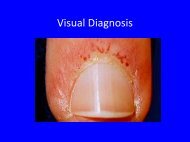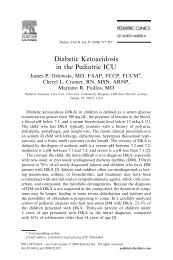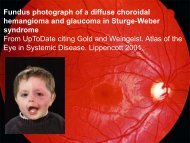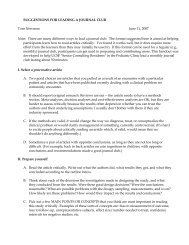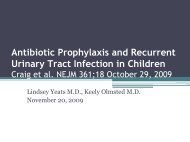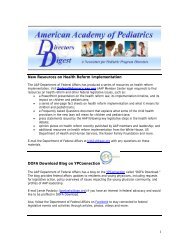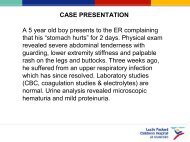DOI: 10.1542/peds.2009-1324 2010;125;e481-e488; originally ...
DOI: 10.1542/peds.2009-1324 2010;125;e481-e488; originally ...
DOI: 10.1542/peds.2009-1324 2010;125;e481-e488; originally ...
You also want an ePaper? Increase the reach of your titles
YUMPU automatically turns print PDFs into web optimized ePapers that Google loves.
Childhood Obesity and Survival After In-Hospital Pediatric Cardiopulmonary<br />
Resuscitation<br />
Vijay Srinivasan, Vinay M. Nadkarni, Mark A. Helfaer, Scott M. Carey, Robert A.<br />
Berg and for the American Heart Association National Registry of Cardiopulmonary<br />
Resuscitation Investigators<br />
Pediatrics <strong>2010</strong>;<strong>125</strong>;<strong>e481</strong>-<strong>e488</strong>; <strong>originally</strong> published online Feb 22, <strong>2010</strong>;<br />
<strong>DOI</strong>: <strong>10.1542</strong>/<strong>peds.2009</strong>-<strong>1324</strong><br />
The online version of this article, along with updated information and services, is<br />
located on the World Wide Web at:<br />
http://www.pediatrics.org/cgi/content/full/<strong>125</strong>/3/<strong>e481</strong><br />
PEDIATRICS is the official journal of the American Academy of Pediatrics. A monthly<br />
publication, it has been published continuously since 1948. PEDIATRICS is owned, published,<br />
and trademarked by the American Academy of Pediatrics, 141 Northwest Point Boulevard, Elk<br />
Grove Village, Illinois, 60007. Copyright © <strong>2010</strong> by the American Academy of Pediatrics. All<br />
rights reserved. Print ISSN: 0031-4005. Online ISSN: 1098-4275.<br />
Downloaded from<br />
www.pediatrics.org by Alisa Arunamata on November 2, <strong>2010</strong>
Childhood Obesity and Survival After In-Hospital<br />
Pediatric Cardiopulmonary Resuscitation<br />
AUTHORS: Vijay Srinivasan, MD, a Vinay M. Nadkarni, MD, a<br />
Mark A. Helfaer, MD, a Scott M. Carey, b and Robert A. Berg,<br />
MD, a for the American Heart Association National<br />
Registry of Cardiopulmonary Resuscitation Investigators<br />
aDepartment of Anesthesiology and Critical Care Medicine,<br />
Children’s Hospital of Philadelphia and University of<br />
Pennsylvania, Philadelphia, Pennsylvania; and bDepartment of<br />
Bioinformatics, Johns Hopkins Bayview Medical Center,<br />
Baltimore, Maryland<br />
KEY WORDS<br />
cardiopulmonary resuscitation, obesity, pediatrics, survival,<br />
cardiac arrest, registry<br />
ABBREVIATIONS<br />
CPR—cardiopulmonary resuscitation<br />
NRCPR—National Registry of Cardiopulmonary Resuscitation<br />
IQR—interquartile range<br />
OR—odds ratio<br />
CI—confidence interval<br />
www.pediatrics.org/cgi/doi/<strong>10.1542</strong>/<strong>peds.2009</strong>-<strong>1324</strong><br />
doi:<strong>10.1542</strong>/<strong>peds.2009</strong>-<strong>1324</strong><br />
Accepted for publication Oct 28, 2009<br />
Address correspondence to Vijay Srinivasan, MD, Department of<br />
Anesthesiology and Critical Care Medicine, Children’s Hospital of<br />
Philadelphia, 34th Street and Civic Center Boulevard,<br />
Philadelphia, PA 19104. E-mail: srinivasan@email.chop.edu<br />
PEDIATRICS (ISSN Numbers: Print, 0031-4005; Online, 1098-4275).<br />
Copyright © <strong>2010</strong> by the American Academy of Pediatrics<br />
FINANCIAL DISCLOSURE: Dr Nadkarni received grant support<br />
from Respironics and the Ross Products Division of Abbott<br />
Laboratories and equipment from Laerdal Medical Corp. Mr<br />
Carey provided data management consulting for Digital<br />
Innovation. Dr Berg received grant support from Medtronic<br />
Emergency Response Systems and Laerdal Medical Corp.<br />
WHAT’S KNOWN ON THIS SUBJECT: Childhood obesity is a public<br />
health crisis of epidemic proportions. CPR and advanced life<br />
support for obese children experiencing cardiopulmonary arrest<br />
may be complicated by difficulties with CPR quality and drug<br />
dosages.<br />
WHAT THIS STUDY ADDS: Childhood obesity is associated with a<br />
lower rate of survival to hospital discharge after in-hospital,<br />
pediatric CPR.<br />
abstract<br />
ARTICLES<br />
OBJECTIVE: We hypothesized that childhood obesity would be associated<br />
with decreased likelihood of survival to hospital discharge after<br />
in-hospital, pediatric cardiopulmonary resuscitation (CPR).<br />
METHODS: We reviewed 1477 consecutive, pediatric, CPR index events<br />
(defined as the first CPR event during a hospitalization in that facility<br />
for a patient 18 years of age) reported to the American Heart Association<br />
National Registry of Cardiopulmonary Resuscitation between<br />
January 2000 and July 2004. The primary outcome was survival to<br />
hospital discharge. A total of 1268 index subjects (86%) with complete<br />
registry data were included for analysis. Children were classified as<br />
obese (95th weight-for-length percentile if 2 years of age or 95th<br />
BMI-for-age percentile if 2 years of age) or underweight (5th<br />
weight-for-length percentile if 2 years of age or 5th BMI-for-age<br />
percentile if 2 years of age), with adjustment for gender.<br />
RESULTS: Obesity was noted for 213 (17%) of 1268 subjects and underweight<br />
for 571 (45%) of 1268 subjects. Obesity was more likely to be<br />
associated with male gender, noncardiac medical illness, and cancer<br />
and inversely associated with heart failure. Underweight was more<br />
likely to be associated with male gender, cardiac surgery, and prematurity<br />
and inversely associated with age and cancer. Self-reported,<br />
process-of-care, CPR quality was generally worse for obese children.<br />
With adjustment for important potential confounding factors, obesity<br />
was independently associated with worse odds of event survival (adjusted<br />
odds ratio: 0.58 [95% confidence interval: 0.35–0.76]) and survival<br />
to hospital discharge (adjusted odds ratio: 0.62 [95% confidence<br />
interval: 0.38–0.93]) after in-hospital, pediatric CPR. Underweight was<br />
not associated with worse outcomes.<br />
CONCLUSIONS: Childhood obesity is associated with a lower rate of<br />
survival to hospital discharge after in-hospital, pediatric CPR.<br />
Pediatrics <strong>2010</strong>;<strong>125</strong>:<strong>e481</strong>–<strong>e488</strong><br />
PEDIATRICS Volume <strong>125</strong>, Number 3, March <strong>2010</strong> <strong>e481</strong><br />
Downloaded from<br />
www.pediatrics.org by Alisa Arunamata on November 2, <strong>2010</strong>
Childhood obesity is a public health crisis<br />
of epidemic proportions throughout<br />
the world, with an estimated<br />
prevalence of 10% to 25%. 1–3 Cardiopulmonary<br />
resuscitation (CPR) and advanced<br />
life support for obese children<br />
experiencing cardiopulmonary arrest<br />
may be complicated by difficulties with<br />
the quality of CPR and problems with<br />
drug dosages. Specifically, the obese<br />
body habitus may pose distinct difficulties<br />
with airway management and effective<br />
chest compressions. In addition,<br />
pediatric advanced life support<br />
medications typically are administered<br />
on the basis of body weight<br />
but plasma concentrations of highly<br />
water-soluble medications may be<br />
substantially higher and potentially<br />
toxic in obese children when medications<br />
are dosed according to weight.<br />
Conversely, lipid-soluble medications<br />
may not reach adequate concentrations<br />
in obese children. 4<br />
The relationship of childhood obesity<br />
to survival after CPR is not well known.<br />
We evaluated the association between<br />
obesity and outcomes among children<br />
after in-hospital CPR in the American<br />
Heart Association National Registry of<br />
Cardiopulmonary Resuscitation (NRCPR),<br />
a large, multicenter registry of inhospital<br />
cardiac arrests. 5 We hypothesized<br />
that obese children would be less<br />
likely to survive to hospital discharge<br />
after in-hospital, pediatric CPR, compared<br />
with nonobese children.<br />
METHODS<br />
Study Design and Population<br />
The NRCPR is a prospective, multisite,<br />
in-hospital resuscitation registry<br />
sponsored by the American Heart Association,<br />
with voluntary, fee-based<br />
membership. At each participating institution,<br />
certified research coordinators<br />
abstract information about each<br />
CPR event from hospital medical<br />
records. The resulting database contains<br />
precisely defined variables de-<br />
e482 SRINIVASAN et al<br />
rived from the Utstein-style datareporting<br />
guidelines for cardiac<br />
arrest. 6,7 Case-study methods are used<br />
to evaluate data abstraction, the accuracy<br />
of entries, and compliance with<br />
operational definitions. The 6 major<br />
categories of variables are facility<br />
data, patient demographic data,<br />
preevent data, event data, outcome<br />
data, and quality-improvement data.<br />
The data are submitted securely, in<br />
compliance with Healthcare Information<br />
Portability and Accountability Act<br />
regulations, to a central data repository<br />
(Digital Innovation, Forest Hill,<br />
MD). The American Heart Association<br />
oversees the entire process of data<br />
collection, analysis, and reporting,<br />
through its national center staff, scientific<br />
advisory board, and executive database<br />
steering committee. The primary<br />
purpose of the NRCPR is quality<br />
improvement through monitoring of<br />
process-of-care standards, compliance,<br />
and benchmarking against national<br />
and peer standards. This study<br />
was approved by the institutional review<br />
board at the Children’s Hospital of<br />
Philadelphia.<br />
Data from 167 participating NRCPR<br />
hospitals that recorded cardiopulmonary<br />
arrests among patients 18<br />
years of age and provided 6 months<br />
of data from January 1, 2000, through<br />
July 31, 2004, were analyzed. All patients<br />
18 years of age who were<br />
treated with CPR at participating institutions<br />
were eligible for this study. According<br />
to NRCPR operational definitions,<br />
a CPR event was any event<br />
treated with chest compressions when<br />
a unit-wide or hospital-wide emergency<br />
response was activated, with<br />
the exclusion of events that commenced<br />
out of hospital and events involving<br />
newborn infants in the delivery<br />
suite. An index event was defined as<br />
the patient’s first CPR event during the<br />
hospitalization. Only index events were<br />
eligible for inclusion in the study. Ar-<br />
Downloaded from<br />
www.pediatrics.org by Alisa Arunamata on November 2, <strong>2010</strong><br />
rests among patients with “do not attempt<br />
resuscitation” orders and arrests<br />
that were resolved through<br />
implantable cardioverter-defibrillator<br />
shocks also were excluded.<br />
The NRCPR does not collect data on<br />
the height or length of subjects. Therefore,<br />
BMI values were calculated on the<br />
basis of median height-for-age values<br />
adjusted for gender, by using World<br />
Health Organization Anthro 2.0.4 and<br />
Anthroplus 1.0.2 software (World<br />
Health Organization, Geneva, Switzerland).<br />
BMI-for-age percentiles and weightfor-length<br />
percentiles, with corresponding<br />
z scores, were computed as<br />
appropriate. 8,9 Weight-for-length percentiles<br />
are a well-established growth<br />
standard for children 2 years of<br />
age, 8 whereas BMI-for-age percentiles<br />
are considered accurate to describe<br />
growth for children 2 years of age. 9<br />
Children were classified as obese<br />
(95th weight-for-length percentile if<br />
2 years of age or 95th BMI-for-age<br />
percentile if 2 years of age) or underweight<br />
(5th weight-for-length<br />
percentile if 2 years of age or 5th<br />
BMI-for-age percentile if 2 years of<br />
age), with adjustment for gender, on<br />
the basis of reference data collected<br />
by the World Health Organization. 10<br />
The prospectively selected, primary<br />
outcome measure was survival to<br />
hospital discharge. 6,7 Secondary outcome<br />
measures included survival of<br />
event (defined as return of spontaneous<br />
circulation for 20 minutes)<br />
and survival with favorable neurologic<br />
outcome. The neurologic outcome<br />
was determined according to<br />
the Pediatric Cerebral Performance<br />
Category scale, in which category 1<br />
represents a normal neurologic<br />
state, 2 mild disability, 3 moderate<br />
disability, 4 severe disability, 5 coma<br />
or vegetative state, and 6 death. 11,12<br />
Neurologic status before the arrest<br />
and at discharge was determined<br />
through chart review. A favorable
FIGURE 1<br />
Enrollment and outcomes. Underweight indicates 5th weight-for-length percentile (for children 2<br />
years of age) or 5th BMI-for-age percentile (for children 2 years of age). Obesity indicates 95th<br />
weight-for-length percentile (for children 2 years of age) or 95th BMI-for-age percentile (for<br />
children 2 years of age). ROSC indicates return of spontaneous circulation.<br />
neurologic outcome was defined by a<br />
Pediatric Cerebral Performance Category<br />
score of 1, 2, or 3 or no change<br />
from baseline scores. 13<br />
Statistical Analyses<br />
Summary results are presented as<br />
means SDs for variables that were<br />
distributed normally. Variables that<br />
were not distributed normally are presented<br />
as medians and interquartile<br />
ranges (IQRs). Differences between<br />
groups were analyzed through analysis<br />
of variance for continuous variables<br />
and the 2 test for dichotomous<br />
variables. Posthoc comparisons were<br />
performed with regard to the normalweight<br />
group by using the Bonferroni<br />
method for multiple comparisons.<br />
Variables associated with obesity and<br />
underweight in univariate analyses<br />
(P .20) were included in stepwise,<br />
multivariate, logistic regression analyses<br />
to characterize their association<br />
with obesity and underweight. Finally,<br />
all factors associated with primary<br />
and secondary outcomes in univariate<br />
analyses (P .20) were included in<br />
stepwise, multivariate, logistic regression<br />
analyses to characterize the asso-<br />
ciation of obesity and underweight<br />
with outcome measures adjusted for<br />
confounding factors. Odds ratios (ORs)<br />
with 95% confidence intervals (CIs)<br />
were reported. All P values are 2-sided,<br />
and P values were considered significant<br />
at .05.<br />
RESULTS<br />
A total of 1477 children experienced index<br />
CPR events in 167 participating<br />
centers. Of those, 1268 (86%) had complete<br />
registry data recorded and were<br />
included for further analysis (Fig 1).<br />
Obesity was noted for 213 (17%) of<br />
1268 subjects and underweight for 571<br />
(45%) of 1268 subjects. For children<br />
2 years of age, the median weightfor-length<br />
percentile was 0.4 (IQR:<br />
0.01–29.55), with a median z score of<br />
2.67 (IQR: 4.99 to 0.54). For children<br />
2 years of age, the median BMIfor-age<br />
percentile was 68.9 (IQR: 6.3–<br />
96.3), with a median z score of 0.51<br />
(IQR: 1.53 to 1.79). Infants (age of 1<br />
year) were only 22% of the obese<br />
group, compared with 34% of the<br />
normal-weight group and 72% of the<br />
underweight group (P .001).<br />
ARTICLES<br />
The prearrest and arrest characteristics<br />
of the patients were compared<br />
across all 3 weight categories (Tables<br />
1 and 2). The median ages were 48<br />
months for obese patients, 5 months<br />
for underweight patients, and 30<br />
months for the other children (P <br />
.001). Both obese and underweight patients<br />
were more likely to be male than<br />
were the other children (P .01).<br />
Obese patients were more likely to<br />
have a noncardiac medical illness or<br />
trauma, whereas underweight patients<br />
were more likely to have undergone<br />
cardiac surgery (P .001). Infection,<br />
cancer, trauma, and neurologic<br />
dysfunction were more-common preexisting<br />
conditions among obese patients,<br />
whereas congestive heart failure<br />
and prematurity were more<br />
common among underweight patients.<br />
In all 3 weight categories, acute respiratory<br />
insufficiency and hypotension<br />
were the most-common immediately<br />
precipitating causes of arrest. Underweight<br />
patients were more likely to<br />
have acute respiratory insufficiency as<br />
an immediate cause of arrest, compared<br />
with obese patients and other<br />
children (P .001).<br />
Of the 1268 CPR events, 725 (57%) involved<br />
initially pulseless cardiac arrests<br />
and 543 (43%) severe bradycardia<br />
with pulses. Because 245 of 543<br />
events with initial pulses subsequently<br />
became pulseless, a total of 969 (76%)<br />
of 1268 patients experienced pulseless<br />
cardiac arrests. Obese patients more<br />
often were pulseless throughout the<br />
event (69% of obese patients, compared<br />
with 51% of underweight patients<br />
and 60% of other patients; P <br />
.001). Obese patients also were more<br />
likely to have a first documented electrocardiographic<br />
rhythm of asystole<br />
(37% of obese patients, compared with<br />
26% of underweight patients and 32%<br />
of other patients; P .05). The median<br />
number of epinephrine doses during<br />
CPR was greatest in the obese group (4<br />
PEDIATRICS Volume <strong>125</strong>, Number 3, March <strong>2010</strong> e483<br />
Downloaded from<br />
www.pediatrics.org by Alisa Arunamata on November 2, <strong>2010</strong>
TABLE 1 Prearrest Characteristics of Patients<br />
Prearrest Characteristic Obesity (N 213) Normal Weight (N 484) Underweight (N 571) P<br />
Age, median (IQR), mo 48 (17–144) a 30 (8–132) 5 (1–16) a .001<br />
Male, n (%) 124 (58) a 225 (46) 334 (58) a .001<br />
BMI, median (IQR), kg/m2 22.7 (19.7–28.2) a 16.2 (15–18.3) 11 (9.3–12.6) a .001<br />
BMI-for-age percentile, median (IQR) 99.6 (98.5–99.9) a 47.3 (21.4–76.4) 0.01 (0.01–0.3) a .001<br />
BMI-for-age percentile z score, median (IQR) 2.62 (2.17–3.75) a 0.07 (0.79 to 0.72) 3.94 (5.73 to 2.75) a Race or ethnicity, n (%)<br />
.001<br />
White 120 (56) 275 (57) 302 (53) .40<br />
Black 44 (21) 108 (22) 141 (25) .43<br />
Other 31 (15) 66 (14) 74 (13) .84<br />
Unknown/not documented<br />
Facility type, n (%)<br />
18 (8) 35 (7) 54 (9) .43<br />
Pediatric 85 (40) 229 (47) 312 (55) a .001<br />
Adult 11 (5) 25 (5) 6 (1) a .001<br />
Mixed<br />
Event location, n (%)<br />
117 (55) 230 (48) 253 (44) .05<br />
ICU 156 (73) 333 (69) 405 (71) .48<br />
Operating room 5 (2) 24 (5) 16 (3) .10<br />
Emergency department 23 (11) 48 (10) 41 (7) .16<br />
Inpatient, monitored 6 (3) 30 (6) 32 (6) .18<br />
Inpatient ward 14 (7) 29 (6) 48 (8) .30<br />
Other/unknown<br />
Illness category, n (%)<br />
9 (4) 20 (4) 29 (5) .74<br />
Medical, cardiac 29 (14) 85 (18) 107 (19) .24<br />
Medical, noncardiac 130 (61) a 225 (46) 245 (43) .001<br />
Surgical, cardiac 8 (4) a 69 (14) 166 (29) a .001<br />
Surgical, noncardiac 10 (5) 44 (9) 42 (7) .13<br />
Trauma 33 (15) 57 (12) 7 (1) a .001<br />
Other<br />
Preexisting conditions, n (%)<br />
3 (1) 4 (1) 4 (1) .63<br />
Respiratory insufficiency 121 (57) 278 (57) 387 (68) a .001<br />
Hypotension 88 (41) 191 (39) 189 (33) .05<br />
Congestive heart failure 22 (10) a 112 (23) 195 (34) a .001<br />
Arrhythmia 38 (18) 94 (19) 115 (20) .77<br />
Infection (pneumonia or sepsis) 79 (37) a 116 (24) 157 (27) .01<br />
Renal insufficiency 29 (14) 61 (13) 66 (12) .71<br />
Hepatic insufficiency 16 (8) 31 (6) 36 (6) .82<br />
Cancer 19 (9) 35 (7) 15 (3) a .001<br />
Major trauma 40 (19) 57 (12) 8 (1) a .001<br />
Metabolic/electrolyte abnormality 44 (21) 99 (20) 128 (22) .71<br />
Toxicologic abnormality 4 (2) 6 (1) 4 (1) .35<br />
Central nervous system disorder 72 (34) 153 (32) 142 (25) .05<br />
Prematurity 8 (4) 23 (5) 120 (21) a Mode of discovery of event, n (%)<br />
.001<br />
Witnessed 193 (91) 457 (94) 543 (95) .06<br />
Monitored through electrocardiography 178 (84) 424 (88) 494 (87) .36<br />
Monitored through pulse oximetry<br />
Existing interventions in place, n (%)<br />
179 (84) 421 (87) 514 (90) .06<br />
Vascular access 193 (91) 439 (91) 506 (89) .49<br />
Arterial catheter 58 (27) 161 (33) 183 (32) .28<br />
Mechanical ventilation 124 (58) 304 (63) 341 (60) .43<br />
Vasoactive infusion 79 (37) 208 (43) 219 (38) .20<br />
Dialysis/extracorporeal membrane oxygenation 7 (3) 20 (4) 12 (2) .16<br />
a P .001, adjusted for posthoc comparisons with normal-weight group.<br />
doses, compared with 3 doses in each<br />
of the other groups; P .005), and<br />
obese patients more often received 2<br />
doses of epinephrine (43%, compared<br />
with 29% in each of the other groups;<br />
P .001). Obese patients were more<br />
e484 SRINIVASAN et al<br />
likely to receive vasopressin, magnesium,<br />
lidocaine, and amiodarone, compared<br />
with the other 2 groups (P .05),<br />
and were less likely to be treated with<br />
extracorporeal membrane oxygenation<br />
therapy (P .05).<br />
Downloaded from<br />
www.pediatrics.org by Alisa Arunamata on November 2, <strong>2010</strong><br />
Because both obesity and underweight<br />
might have resulted in advanced life<br />
support challenges, we analyzed selfreported,<br />
process-of-care, quality issues<br />
during CPR across weight categories.<br />
Overall, the obese group
TABLE 2 Arrest Characteristics of Patients<br />
Arrest Characteristic Obesity<br />
(N 213)<br />
experienced more problems with resuscitation<br />
team function (eg, deviations<br />
from pediatric advanced life support<br />
protocols), compared with the<br />
other categories (10% of resuscitations<br />
for obese patients, compared<br />
with 5% for underweight patients and<br />
7% for other patients; P .05). Invasive<br />
airway problems (delays, multiple<br />
attempts, and misplacement) tended<br />
to be more common with both obese<br />
Normal Weight<br />
(N 484)<br />
Underweight<br />
(N 571)<br />
Immediate factors related to event, n (%)<br />
Acute respiratory insufficiency 99 (47) 242 (50) 348 (61) a .001<br />
Hypotension 123 (58) 298 (62) 313 (55) .09<br />
Metabolic/electrolyte disturbance 30 (14) 48 (10) 66 (12) .27<br />
Acute pulmonary edema 13 (6) 16 (3) 4 (1) .001<br />
Airway obstruction<br />
State of pulse during event, n (%)<br />
11 (5) 22 (5) 30 (5) .86<br />
Pulse absent throughout event 146 (69) a 289 (60) 290 (51) a .001<br />
Pulse initially present and later absent 33 (15) 88 (18) 124 (22) .11<br />
Pulse present throughout event<br />
First documented pulseless rhythm, n (%)<br />
34 (16) 107 (22) 157 (27) .05<br />
Asystole 78 (37) 155 (32) 151 (26) .05<br />
Pulseless electrical activity 48 (20) 88 (18) 90 (16) .09<br />
VF/pulseless VT 29 (14) 64 (13) 49 (9) .05<br />
Unknown/not documented<br />
Pulse rhythm (when pulse present), n (%)<br />
21 (10) 60 (12) 102 (18) .005<br />
Bradycardia 48 (23) a 150 (31) 230 (40) a .001<br />
Sinus (including sinus tachycardia) 9 (4) 18 (4) 23 (4) .94<br />
Ventricular tachycardia, with pulse 1 (0) 10 (2) 3 (1) .05<br />
Unknown/not documented 8 (4) 13 (3) 21 (4) .62<br />
Interval to initiation of CPR, median (IQR), min 0 (0–0) 0 (0–0) 0 (0–0) .5<br />
Duration of CPR, median (IQR), minb 25 (9.5–43) 21 (8.25–40) 20 (8–36) .14<br />
Any VF/pulseless VT, n (%) 55 (26) 121 (25) 92 (16) a .001<br />
Interval to first defibrillation, median (IQR), min 0 (0–6) 2 (0–3) 1 (0–4) .16<br />
Interval to first epinephrine dose, median (IQR), min<br />
No. of epinephrine doses<br />
1 (0–5) 0 (0–3) 0 (0–4) .44<br />
Median (IQR) 4 (2–7) a 3 (2–5) 3 (1–5) .005<br />
0, n (%) 21 (10) 80 (17) 116 (20) .05<br />
1or2,n (%) 41 (19) 104 (21) 130 (23) .56<br />
2, n (%) 91 (43) a 141 (29) 168 (29) .001<br />
Unknown, n (%)<br />
Pharmacologic interventions, n (%)<br />
60 (28) 159 (33) 157 (28) .14<br />
Fluid bolus 99 (46) 192 (40) 190 (33) .14<br />
Dextrose with insulin 2 (1) 12 (2) 21 (4) .10<br />
Atropine 92 (43) 187 (39) 224 (39) .51<br />
Sodium bicarbonate 142 (67) 293 (61) 333 (58) .10<br />
Calcium 97 (46) 220 (45) 267 (47) .90<br />
Vasopressin 12 (6) 29 (6) 12 (2) a .005<br />
Magnesium sulfate 20 (9) 28 (6) 27 (5) .05<br />
Amiodarone 21 (10) 34 (7) 17 (3) .001<br />
Lidocaine<br />
Nonpharmacologic interventions, n (%)<br />
37 (17) 73 (15) 56 (10) .01<br />
Extracorporeal membrane oxygenation therapy 8 (4) 27 (6) 48 (8) .05<br />
Pacemaker 14 (7) 45 (9) 47 (8) .48<br />
VF indicates ventricular fibrillation; VT, ventricular tachycardia.<br />
a P .001, adjusted for posthoc comparisons with normal-weight group.<br />
b Data were not available for 147 patients.<br />
(14%) and underweight (12%) patients,<br />
compared with normal-weight<br />
patients (9%; P .10). Of all patients<br />
without a preexisting invasive airway<br />
at the time of the event, obese patients<br />
tended to receive CPR for a longer time<br />
than did patients in other weight categories<br />
(median: 33.5 vs 22 minutes;<br />
P .08). Vascular access problems (ie,<br />
not obtaining vascular access and/or extravasations)<br />
also tended to occur more<br />
P<br />
ARTICLES<br />
commonly among obese (5%) and underweight<br />
(6%) patients, compared with<br />
patients of normal weight (2%; P .09).<br />
Providers reported more difficulties<br />
with defibrillation (ie, delays in pad<br />
placement, problems with selection of<br />
the energy dose, and not providing defibrillation<br />
when indicated) with obese patients<br />
(5% of obese patients, compared<br />
with 1% of underweight patients and 3%<br />
of other patients; P .05).<br />
The factors significantly associated<br />
with obesity and underweight during<br />
in-hospital, pediatric CPR, with controlling<br />
for duration of CPR, in stepwise,<br />
multivariate, logistic regression analyses<br />
are shown in Table 3. Obesity was<br />
more likely to be associated with male<br />
gender, noncardiac medical illness,<br />
and cancer and was less likely to be<br />
associated with congestive heart failure.<br />
Underweight was more likely to be<br />
associated with younger age, male<br />
gender, cardiac surgery, and prematurity<br />
and was less likely to be associated<br />
with cancer.<br />
With controlling for confounding factors<br />
(age, gender, facility type, event<br />
TABLE 3 Variables Significantly Associated<br />
With Obesity and Underweight<br />
Weight<br />
Category<br />
Variable OR (95% CI)<br />
Obesity Male gender<br />
Illness category<br />
1.76 (1.23–2.53)<br />
Medical<br />
(noncardiac)<br />
Preexisting illness<br />
2.21 (1.13–3.87)<br />
Heart failure 0.33 (0.19–0.59)<br />
Cancer 2.25 (1.12–3.93)<br />
Underweight Age 0.98 (0.97–0.99)<br />
Male gender<br />
Illness category<br />
1.59 (1.20–2.13)<br />
Cardiac surgery<br />
Preexisting illness<br />
1.97 (1.28–3.02)<br />
Cancer 0.44 (0.21–0.89)<br />
Prematurity 3.39 (2.04–5.63)<br />
The variables included in the multivariate logistic regression<br />
model were age, gender, facility type, event location,<br />
illness category, preexisting conditions, interventions in<br />
place at the time of the event, immediate precipitating<br />
causes, monitored/witnessed event, arrest rhythm, advanced<br />
cardiac life support medications, extracorporeal<br />
membrane oxygenation therapy, and duration of CPR. Data<br />
for 147 patients were excluded in this analysis because<br />
the exact duration of CPR was not documented.<br />
PEDIATRICS Volume <strong>125</strong>, Number 3, March <strong>2010</strong> e485<br />
Downloaded from<br />
www.pediatrics.org by Alisa Arunamata on November 2, <strong>2010</strong>
TABLE 4 Weight and Outcomes of CPR<br />
Outcomes Obesity vs<br />
Underweight vs<br />
Primary outcome, survival to hospital discharge<br />
Normal Weight<br />
Normal Weight<br />
Rate, % 23 vs 34 39 vs 34<br />
Adjusted OR (95% CI)<br />
Secondary outcomes<br />
Survival of event (return of spontaneous<br />
circulation for 20 min)<br />
0.62 (0.38–0.93) 1.16 (0.79–1.67)<br />
Rate, % 53 vs 66 70 vs 66<br />
Adjusted OR (95% CI)<br />
Survival with favorable neurologic outcome<br />
0.58 (0.35–0.76) 1.23 (0.94–1.62)<br />
Rate, % 15 vs 20 27 vs 20<br />
Adjusted OR (95% CI) 0.69 (0.33–1.24) 1.44 (0.93–2.06)<br />
The ORs were adjusted for factors associated with each outcome measure in multivariate logistic regression analyses. The<br />
variables included in the model were age, gender, facility type, event location, illness category, preexisting conditions,<br />
interventions in place at the time of the event, immediate precipitating causes, monitored/witnessed event, arrest rhythm,<br />
advanced cardiac life support medications, extracorporeal membrane oxygenation therapy, and duration of CPR. Data for<br />
147 patients were excluded in this analysis because the duration of CPR was not documented.<br />
location, illness category, preexisting<br />
conditions, interventions in place at<br />
the time of the event, immediate<br />
precipitating causes, monitored/witnessed<br />
event, arrest rhythm, concurrent<br />
advanced cardiac life support<br />
medications, extracorporeal membrane<br />
oxygenation therapy, and duration<br />
of CPR), obesity was independently<br />
associated with worse rates of<br />
event survival and survival to discharge<br />
(Table 4). In contrast, underweight<br />
was not associated with worse<br />
rates of event survival or survival to<br />
discharge.<br />
DISCUSSION<br />
The data from this large, multicenter<br />
registry of in-hospital, pediatric cardiopulmonary<br />
arrests established that<br />
obese children had worse survival<br />
rates after in-hospital, pediatric CPR.<br />
They were less likely to survive the CPR<br />
event and less likely to survive to hospital<br />
discharge. Surprisingly, the outcomes<br />
of children who were underweight<br />
were at least as good as those<br />
of children with normal weights. Although<br />
other studies demonstrated<br />
that childhood obesity is generally associated<br />
with increased morbidity and<br />
mortality rates, 14–16 this is the first<br />
study that demonstrates an association<br />
between childhood obesity and<br />
outcomes after CPR.<br />
e486 SRINIVASAN et al<br />
Why was obesity associated with<br />
worse outcomes after in-hospital, pediatric<br />
CPR in our study? First, it is possible<br />
that providers have more difficulty<br />
attaining adequate force and<br />
depth of compressions with obese<br />
children, compared with thinner children.<br />
The effectiveness of chest compression<br />
force and depth with respect<br />
to blood flow during CPR may be attenuated<br />
because of anatomic and physiologic<br />
effects of obesity. For example,<br />
obesity is associated independently<br />
with increased abdominal pressure,<br />
low lung volumes with atelectasis, low<br />
lung compliance, and low chest wall<br />
compliance, 17,18 all of which may attenuate<br />
blood flow during CPR. Second,<br />
the dosing of pediatric advanced life<br />
support medications on the basis of<br />
actual weight is potentially hazardous<br />
for obese children. Although there is a<br />
paucity of data regarding optimal dosing<br />
of resuscitation medications for<br />
children of any weight, plasma concentrations<br />
of highly water-soluble medications<br />
with small volumes of distribution,<br />
such as epinephrine, may be<br />
substantially higher in obese children<br />
and therefore potentially toxic. 19 Conversely,<br />
highly lipid-soluble medications,<br />
such as amiodarone, have larger<br />
volumes of distribution in obese patients,<br />
20 and much higher doses may<br />
Downloaded from<br />
www.pediatrics.org by Alisa Arunamata on November 2, <strong>2010</strong><br />
be needed to attain comparable effects<br />
in obese patients. Third, because<br />
defibrillation doses for children also<br />
are weight-based (ie, 2 J/kg), much<br />
higher doses may be provided to obese<br />
children, compared with other children<br />
the same length or age. It is possible<br />
that higher doses result in<br />
greater postresuscitation myocardial<br />
dysfunction. 21 Alternatively, it is plausible<br />
that obese subjects require<br />
greater defibrillation energies than<br />
the weight-based doses for successful<br />
resuscitation. Fourth, the processes of<br />
care and resuscitation team dynamics<br />
during CPR tended to be more difficult<br />
for obese children, which might have<br />
been a significant determinant of poor<br />
outcomes.<br />
The lack of an association between underweight<br />
and worse survival outcomes<br />
is somewhat surprising. Studies<br />
with critically ill adults observed<br />
associations of low BMI values with<br />
higher mortality rates and worse functional<br />
status at hospital discharge. 22–24<br />
In the present study, underweight children<br />
were generally younger, more<br />
likely to receive care in pediatric facilities,<br />
and more likely to be in the hospital<br />
for cardiac surgery, each of<br />
which might have favorably influenced<br />
outcomes. 25,26 Low BMI values often<br />
were associated with a malignancy in<br />
the adult studies, whereas the underweight<br />
children in our study were less<br />
likely to have a malignancy than were<br />
either the obese children or the<br />
normal-weight children.<br />
As hypothesized, factors associated<br />
with CPR and advanced life support for<br />
obese children had adverse effects on<br />
survival outcomes. The present study<br />
examined all index CPR events, including<br />
those with no loss of pulses during<br />
the event. When we analyzed outcomes<br />
exclusively for patients who experienced<br />
pulseless cardiac arrest (n <br />
725), obesity continued to be associated<br />
with worse odds of event survival
(adjusted OR: 0.53 [95% CI: 0.31–0.96])<br />
and survival to hospital discharge (adjusted<br />
OR: 0.57 [95% CI: 0.27–0.98]).<br />
The underweight group of patients<br />
who received CPR because of a pulseless<br />
arrest did not differ from the<br />
normal-weight group.<br />
There are several limitations to this<br />
study. Because the NRCPR database<br />
does not include height data, we estimated<br />
BMI values on the basis of median<br />
height-for-age values (or lengthfor-age<br />
values for children 2 years of<br />
age). It is possible that some of the<br />
underweight-for-age children also<br />
were short for age, and their weightfor-length<br />
percentiles (or BMI-for-age<br />
percentiles) might have been normal.<br />
Similarly, some of the heavier children<br />
might have been taller, and their BMI<br />
values might have been normal. However,<br />
both the underweight group and<br />
the obesity group differed from the<br />
normal-weight group with respect to<br />
many factors that seem consistent<br />
with their presumed phenotypes. For<br />
example, obesity was less likely among<br />
children with congestive heart failure<br />
or prematurity, whereas underweight<br />
was more likely among children with<br />
either condition.<br />
The usual limitations of registry data<br />
regarding the integrity and validity of<br />
the data and sampling bias were addressed<br />
through the use of uniform<br />
operational definitions, uniform data<br />
collection, rigorous prospective abstractor<br />
training and competency-<br />
REFERENCES<br />
1. Ogden CL, Carroll MD, Curtin LR, McDowell<br />
MA, Tabak CJ, Flegal KM. Prevalence of overweight<br />
and obesity in the United States,<br />
1999–2004. JAMA. 2006;295(13):1549–1555<br />
2. Haslam DW, James WPT. Obesity. Lancet.<br />
2005;366(9492):1197–1209<br />
3. Wang Y, Lobstein T. Worldwide trends in<br />
childhood overweight and obesity. Int J Pediatr<br />
Obes. 2006;1(1):11–25<br />
4. Luten R, Zaritsky A. The sophistication of<br />
simplicity: optimizing emergency dosing.<br />
Acad Emerg Med. 2008;15(5):461–465<br />
based certification, detailed periodic<br />
reabstraction, and large sample size.<br />
Sampling bias was minimized through<br />
the use of strict inclusion and exclusion<br />
criteria, comprehensive methods to<br />
verify data completeness, large sample<br />
size, and multicenter design. However, it<br />
is possible that the existing NRCPR data<br />
elements fail to capture unmeasured<br />
confounders of outcomes.<br />
Although this is the largest registry of<br />
in-hospital, pediatric cardiac arrests,<br />
the number of events may lack power<br />
for some important comparisons. For<br />
example, the underweight group had<br />
an adjusted OR of 1.16 for survival to<br />
hospital discharge, compared with the<br />
normal-weight group, but the 95% CI<br />
was 0.79 to 1.67. Perhaps these differences<br />
would be statistically significant<br />
with larger numbers. Similarly, the<br />
obese group tended to have worse<br />
rates of survival with favorable neurologic<br />
outcomes but this did not achieve<br />
statistical significance, despite trends<br />
for this important secondary outcome<br />
that paralleled our primary outcome<br />
(survival to hospital discharge).<br />
The implications of these findings are<br />
important in the context of the growing<br />
epidemic of childhood obesity. Providers<br />
need to recognize obese children<br />
and the associated comorbidities that<br />
predispose such children to worse<br />
outcomes after cardiac arrest. Further<br />
investigation is necessary to determine<br />
the effectiveness of weight-based<br />
medication and defibrillation dosing<br />
5. Peberdy MA, Kaye W, Ornato JP, et al. Cardiopulmonary<br />
resuscitation of adults in the<br />
hospital: a report of 14 720 cardiac arrests<br />
from the National Registry of Cardiopulmonary<br />
Resuscitation. Resuscitation. 2003;<br />
58(3):297–308<br />
6. Zaritsky A, Nadkarni V, Hazinski MF, et al.<br />
Recommended guidelines for uniform reporting<br />
of pediatric advanced life support:<br />
the pediatric Utstein Style: a statement for<br />
healthcare professionals from a task force<br />
of the American Academy of Pediatrics, the<br />
ARTICLES<br />
for obese children and to determine<br />
the effectiveness of standard chest<br />
compression techniques for such children.<br />
Perhaps CPR and advanced life<br />
support should be somewhat different<br />
for obese children. In addition, CPR<br />
and advanced life support training<br />
programs may need modification to<br />
address the special needs of obese<br />
children.<br />
CONCLUSIONS<br />
Childhood obesity is associated with a<br />
lower rate of survival to hospital discharge<br />
after in-hospital, pediatric CPR.<br />
Future pediatric CPR investigations<br />
and guidelines may need to address<br />
potential differences in CPR and advanced<br />
life support for obese children.<br />
ACKNOWLEDGMENTS<br />
The Endowed Chair of Pediatric Critical<br />
Care Medicine, Children’s Hospital of<br />
Philadelphia, and the American Heart<br />
Association Emergency Cardiovascular<br />
Care Committee provided funding<br />
for this study.<br />
The American Heart Association NRCPR<br />
investigators include the authors and<br />
R. S. B. Clark, H. Dalton, P. Laussen,<br />
M. C. Morris, F. Moler, C. Parshuram,<br />
A. L. Zaritsky, M. E. Mancini, M. A. Peberdy,<br />
E. Allen, R. S. Braithwaite, B. Eigel,<br />
E. Hunt, W. Kaye, K. Duncan, J. Gosbee,<br />
G. L. Larkin, J. P. Ornato, G. Mears, G.<br />
Nichol, J. Potts, M. Smyth, and T.<br />
Lane-Truitt.<br />
American Heart Association, and the European<br />
Resuscitation Council. Circulation.<br />
1995;92(7):2006–2020<br />
7. Jacobs I, Nadkarni V, Bahr J, et al. Cardiac<br />
arrest and cardiopulmonary resuscitation<br />
outcome reports: update and simplification<br />
of the Utstein templates for resuscitation<br />
registries: a statement for healthcare professionals<br />
from a task force of the International<br />
Liaison Committee on Resuscitation<br />
(American Heart Association, European Resuscitation<br />
Council, Australian Resuscita-<br />
PEDIATRICS Volume <strong>125</strong>, Number 3, March <strong>2010</strong> e487<br />
Downloaded from<br />
www.pediatrics.org by Alisa Arunamata on November 2, <strong>2010</strong>
tion Council, New Zealand Resuscitation<br />
Council, Heart and Stroke Foundation of<br />
Canada, InterAmerican Heart Foundation,<br />
Resuscitation Councils of Southern Africa).<br />
Circulation. 2004;110(21):3385–3397<br />
8. Gibson R. Principles of Nutritional Assessment.<br />
2nd ed. New York, NY: Oxford University<br />
Press; 2005<br />
9. Nash A, Secker D, Corey M, Dunn M, O’Connor DL.<br />
Field testing of the 2006 World Health Organization<br />
charts from birth to 2 years: assessment<br />
of hospital undernutrition and<br />
overnutrition rates and the usefulness of<br />
BMI. JPEN J Parenter Enteral Nutr. 2008;<br />
32(2):145–153<br />
10. Garza C, de Onis M. Rationale for developing<br />
a new international growth reference. Food<br />
Nutr Bull. 2004;25(1 suppl):S5–S14<br />
11. Fiser DH. Assessing the outcome of pediatric<br />
intensive care. J Pediatr. 1992;121(1):<br />
68–74<br />
12. Fiser DH, Long N, Roberson PK, Hefley G, Zolten<br />
K, Brodie-Fowler M. Relation of Pediatric<br />
Overall Performance Category and Pediatric<br />
Cerebral Performance Category scores<br />
at pediatric intensive care unit discharge<br />
with outcome measures collected at hospital<br />
discharge and 1- and 6-month follow-up<br />
assessments. Crit Care Med. 2000;28(7):<br />
2616–2620<br />
13. Reis AG, Nadkarni V, Perondi MP, Grisi S,<br />
Berg RA. A prospective investigation into the<br />
epidemiology of in-hospital pediatric car-<br />
<strong>e488</strong> SRINIVASAN et al<br />
diopulmonary resuscitation using the international<br />
Utstein reporting style. Pediatrics.<br />
2002;109(2):200–209<br />
14. Weiss R, Dziura J, Burgert TS, et al. Obesity<br />
and the metabolic syndrome in children<br />
and adolescents. N Engl J Med. 2004;<br />
350(23):2362–2374<br />
15. Lange BJ, Gerbing RB, Feusner J, et al. Mortality<br />
in overweight and underweight children<br />
with acute myeloid leukemia. JAMA.<br />
2005;293(2):203–211<br />
16. Reilly JJ, Methven E, McDowell ZC, et al.<br />
Health consequences of obesity. Arch Dis<br />
Child. 2003;88(9):748–752<br />
17. Pelosi P, Croci M, Ravagnan I, et al. The effects<br />
of body mass on lung volumes, respiratory<br />
mechanics, and gas exchange during<br />
general anesthesia. Anesth Analg. 1998;<br />
87(3):654–660<br />
18. Pelosi P, Quintel M, Malbrain ML. Effect of<br />
intra-abdominal pressure on respiratory<br />
mechanics. Acta Clin Belg Suppl. 2007;1(1):<br />
78–88<br />
19. Fisher DG, Schwartz PH, Davis AL. Pharmacokinetics<br />
of exogenous epinephrine in critically<br />
ill children. Crit Care Med. 1993;21(1):<br />
111–117<br />
20. Steinberg C, Notterman DA. Pharmacokinetics<br />
of cardiovascular drugs in children: inotropes<br />
and vasopressors. Clin Pharmacokinet.<br />
1994;27(5):345–367<br />
21. Berg MD, Banville IL, Chapman FW, et al. At-<br />
Downloaded from<br />
www.pediatrics.org by Alisa Arunamata on November 2, <strong>2010</strong><br />
tenuating the defibrillation dosage decreases<br />
postresuscitation myocardial dysfunction<br />
in a swine model of pediatric<br />
ventricular fibrillation. Pediatr Crit Care<br />
Med. 2008;9(4):429–434<br />
22. Garrouste-Orgeas M, Troche G, Azoulay E, et<br />
al. Body mass index: an additional prognostic<br />
factor in ICU patients. Intensive Care<br />
Med. 2004;30(3):437–443<br />
23. Tremblay A, Bandi V. Impact of body mass<br />
index on outcomes following critical care.<br />
Chest. 2003;123(4):1202–1207<br />
24. Finkielman JD, Gajic O, Afessa B. Underweight<br />
is independently associated with<br />
mortality in post-operative and nonoperative<br />
patients admitted to the intensive<br />
care unit: a retrospective study. BMC Emerg<br />
Med. 2004;4(1):3<br />
25. Meaney PA, Nadkarni VM, Cook EF, et al.<br />
Higher survival rates among younger patients<br />
after pediatric intensive care unit<br />
cardiac arrests. Pediatrics. 2006;118(6):<br />
2424–2433<br />
26. Donoghue AJ, Nadkarni VM, Elliott M, Durbin<br />
D; American Heart Association National Registry<br />
of Cardiopulmonary Resuscitation<br />
Investigators. Effect of hospital characteristics<br />
on outcomes from pediatric cardiopulmonary<br />
resuscitation: a report from<br />
the National Registry of Cardiopulmonary<br />
Resuscitation. Pediatrics. 2006;118(3):<br />
995–1001
Childhood Obesity and Survival After In-Hospital Pediatric Cardiopulmonary<br />
Resuscitation<br />
Vijay Srinivasan, Vinay M. Nadkarni, Mark A. Helfaer, Scott M. Carey, Robert A.<br />
Berg and for the American Heart Association National Registry of Cardiopulmonary<br />
Resuscitation Investigators<br />
Pediatrics <strong>2010</strong>;<strong>125</strong>;<strong>e481</strong>-<strong>e488</strong>; <strong>originally</strong> published online Feb 22, <strong>2010</strong>;<br />
<strong>DOI</strong>: <strong>10.1542</strong>/<strong>peds.2009</strong>-<strong>1324</strong><br />
Updated Information<br />
& Services<br />
References<br />
Citations<br />
Permissions & Licensing<br />
Reprints<br />
including high-resolution figures, can be found at:<br />
http://www.pediatrics.org/cgi/content/full/<strong>125</strong>/3/<strong>e481</strong><br />
This article cites 25 articles, 11 of which you can access for free<br />
at:<br />
http://www.pediatrics.org/cgi/content/full/<strong>125</strong>/3/<strong>e481</strong>#BIBL<br />
This article has been cited by 3 HighWire-hosted articles:<br />
http://www.pediatrics.org/cgi/content/full/<strong>125</strong>/3/<strong>e481</strong>#otherarticl<br />
es<br />
Information about reproducing this article in parts (figures,<br />
tables) or in its entirety can be found online at:<br />
http://www.pediatrics.org/misc/Permissions.shtml<br />
Information about ordering reprints can be found online:<br />
http://www.pediatrics.org/misc/reprints.shtml<br />
Downloaded from<br />
www.pediatrics.org by Alisa Arunamata on November 2, <strong>2010</strong>



